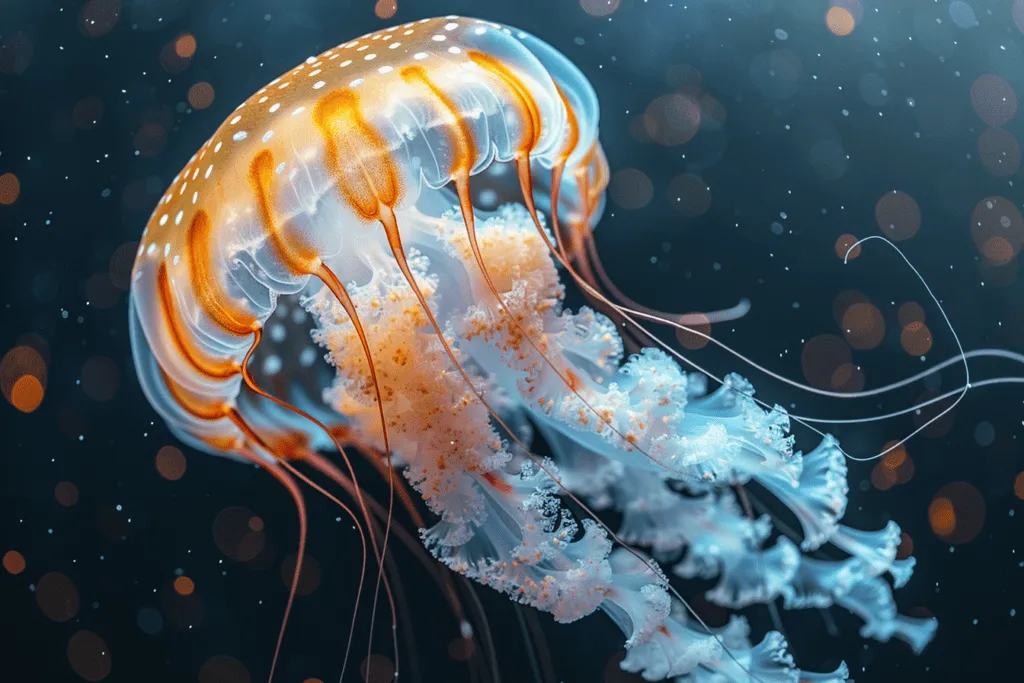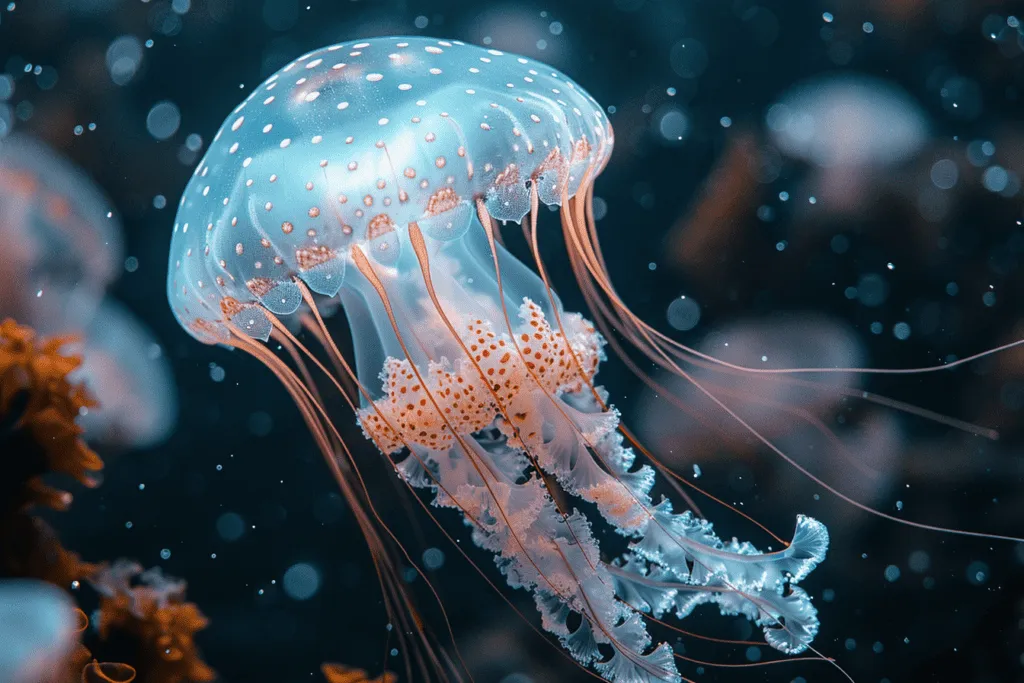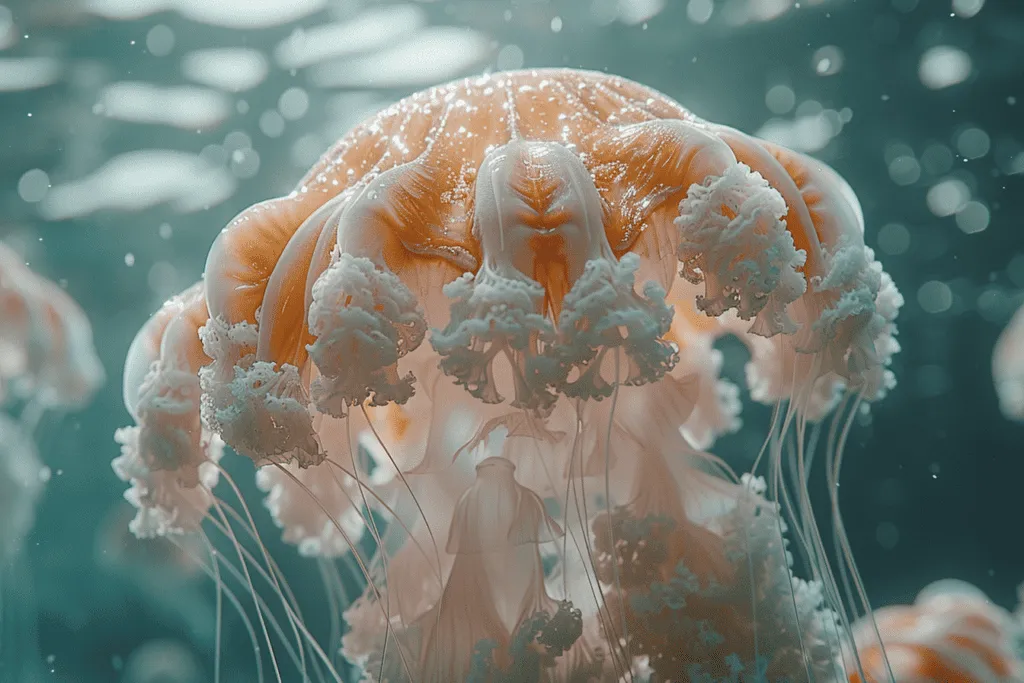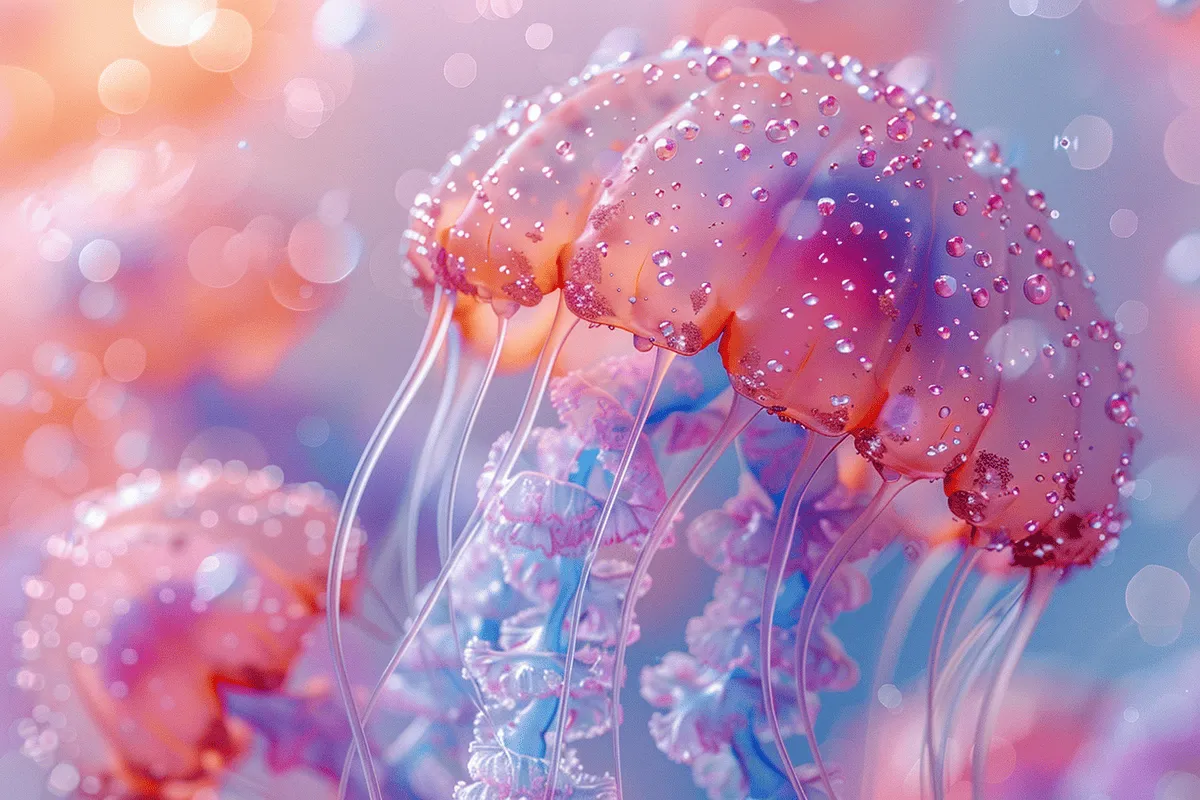10 Jellyfish Facts (Ancient Marvels of the Sea)
Jellyfish have been floating around our oceans for millions of years, way before dinosaurs roamed the Earth. With their ghostly forms and graceful movements, they’re like living, breathing works of art in the water.
But there’s more to these creatures than meets the eye.
From their ability to regenerate lost parts to hosting mini ecosystems within themselves, jellyfish are full of surprises.
If you’re curious about these fascinating ocean dwellers and want to uncover some mind-blowing facts about them, you’ve hit the jackpot!
Scroll down as we unveil our top picks that will make your jaw drop.

1. Jellyfish are among the oldest multicellular organisms on Earth.
Jellyfish have been swimming in our oceans for over 500 million years. That’s way before dinosaurs roamed the Earth!
Imagine, these fascinating marine creatures have witnessed the world change in ways we can only dream of.
They’ve made it through five mass extinctions. Yes, when many other species said goodbye to this world, jellyfish just kept on floating.
It makes you wonder about their secret to survival, doesn’t it?
One reason could be their simple body structure.
Jellyfish are mostly made up of water and have a basic set of cells that allow them to do everything they need—like eat tiny plants or other smaller creatures in the ocean.
Their ability to adapt is nothing short of amazing too.
Jellyfish can live in almost any kind of water—warm tropical seas or icy cold polar oceans.
What’s even more interesting is how jellyfish contribute to marine life today. They’re not just survivors; they play a vital role in the ocean’s ecosystem.
Sea turtles, for example, love munching on certain types of jelly.
2. They lack brains, blood, and bones.
Jellyfish are fascinating creatures. Despite their simple appearance, they’re complex in their own way.
Unlike humans and most animals, jellyfish don’t have brains, blood, or bones. Their bodies are made mostly of water—about 95%! This fact alone makes them unique in the animal kingdom.
These creatures have a basic digestive cavity that serves two purposes: ingestion and excretion.
It’s like having one mouth for both eating food and getting rid of waste. Imagine if people had to do that!
Jellyfish show us there’s more than one way to live life under the sea.
Moving around is another interesting aspect of jellyfish. They don’t swim like fish or crawl like crabs.
Instead, they move by contracting their gelatinous bodies. This method might seem slow or ineffective at first glance but it allows them to glide gracefully through the water with minimal effort.
Did you know some types of jellyfish can even glow in the dark? That’s right!
By contracting their bodies, they activate a natural power that creates beautiful glowing effects underwater—a sight many people find breathtaking.
3. Jellyfish use a simple network of nerves to sense and interact with their environment.
Jellyfish might seem simple, but they have a unique way of sensing their world.
They don’t have brains like us. Instead, they use something called a nerve net. This is a network of nerves spread out through their body.
This nerve net helps them in many ways. For one, it lets them detect changes in water chemistry.
This means they can sense if the water around them has more salt or other chemicals and react to it.
They also use this system to sense light and know which way is up or down.
This is important for jellyfish because knowing where the light comes from helps them find food and avoid dangers.
Lastly, jellyfish can respond to touch stimuli thanks to their nerve net.
If something bumps into them or if they bump into something else, they can feel it even without eyes or hands!
Here’s how these points help jellyfish:
- Detecting changes in water chemistry keeps them safe from harmful environments.
- Sensing light and orientation guides them toward food sources.
- Responding to touch stimuli protects them from predators and obstacles.
4. Some species can glow in the dark due to bioluminescence.
Jellyfish have a unique trick up their sleeve, or rather, in their bodies. They can glow in the dark!
This isn’t just for show; it serves a crucial purpose. By lighting up, they can attract prey that gets mesmerized by the light or scare off predators who might think twice before attacking something so brightly lit.
This glowing magic happens through a process called bioluminescence.
It’s like a chemical party inside the jellyfish where certain substances mix and produce light.
Imagine mixing two types of glow-in-the-dark paint and watching them shine—that’s somewhat similar to what happens inside these creatures.
The result? Stunning underwater light shows that look straight out of a sci-fi movie.
Swimmers and divers sometimes witness these displays, where waves of color sweep through the darkness as jellyfish illuminate parts of the sea with their natural lanterns.
Bioluminescent organs are not just cool features; they’re survival tools for jellyfish, helping them live another day by either luring dinner right into their tentacles or keeping threats at bay with bursts of unexpected light.

5. The box jellyfish is considered the most venomous marine creature.
The box jellyfish, often called the sea’s silent assassin, holds a terrifying record. Its sting can cause death in just minutes.
This isn’t your typical beach hazard; it’s a life-threatening emergency waiting to happen.
What makes the box jellyfish so deadly? It contains toxins that launch a multi-front attack on its victim.
These toxins go straight for the heart and nervous system while also destroying skin cells.
Imagine an invisible enemy that can stop your heart and paralyze you without warning.
Here’s a chilling fact: every year, more people lose their lives to these gelatinous medusas than to shark attacks.
While sharks get all the media attention with their teeth and size, it’s actually this unassuming creature that poses a greater risk to humans.
- Stings: Can be fatal within minutes.
- Toxins: Attack heart, nervous system, and skin cells.
- Annual Deaths: Surpasses those caused by sharks.
6. Jellyfish populations are increasing in some areas, a phenomenon known as “jellyfish blooms”.
Jellyfish blooms happen more often now, and one big reason is overfishing.
When fish that usually eat jellyfish get caught too much, there aren’t enough of them left to keep the jellyfish numbers in check. This leads to more jellyfish.
These extra jellyfish can cause trouble underwater. They eat a lot of plankton, which other marine animals also need to survive.
This can mess up the food chain and harm the balance of life under the sea.
Another problem with too many jellyfish is they can block cooling systems at power plants near the coast.
Specifically, nuclear power plants have had issues because their cooling systems use seawater. When jellyfish clog these systems, it can force the plant to shut down temporarily for cleaning.
Research shows that changes in currents due to climate change might also help these blooms happen more often or in different places than before.
7. They have a lifecycle that includes both solitary and colonial phases.
Jellyfish have a fascinating lifecycle that begins on the seafloor. They start as polyps, attaching themselves firmly to rocks or other surfaces underwater.
During this stage, they might not look like the jellyfish we’re familiar with at all.
As time goes by, these polyps undergo a transformation into free-swimming medusae, the form most of us recognize as jellyfish.
This shift from a stationary life to roaming the seas is like moving out for the first time; it’s a whole new world of freedom and danger.
Some types of jellyfish take this journey together.
Certain species form colonies that work as one big group rather than living solo.
Imagine having thousands of siblings, all moving in harmony! These colonies can be massive and are often mistaken for single giant organisms.
The stages in their lifecycle can vary greatly between different species of jellyfish. Researchers spend a lot of time studying these stages because there’s so much variety.
Some live short lives lasting only a few minutes while others may last longer than many humans!
8. Certain species’ stings can be fatal to humans.
Among the many jellyfish species, box jellyfish are known for having the most dangerous stings. These animals carry poison in their stinging cells that can cause more than just a sharp pain; they have the potential to be deadly.
When someone gets stung by a box jellyfish, they feel immediate and severe pain.
But it’s not just about the discomfort. The poison can lead to something much scarier: cardiovascular collapse.
This means that the heart and blood circulation system start failing, which is extremely serious and can even lead to cardiac arrest if not treated quickly.
There’s a first-aid measure that might seem simple but is very important: vinegar.
Pouring vinegar over the sting area helps deactivate the stingers or nematocysts left on the skin.
This doesn’t cure everything but prevents further discharge of poison into the body while you seek medical help.

9. Jellyfish are a significant part of marine food webs, both as predators and prey.
Jellyfish play a crucial role in marine ecosystems, acting as both hunters and the hunted.
They feast on a variety of smaller sea creatures including tiny fish, plankton, and sometimes even other jellyfish. This diet helps keep the population of these smaller organisms in check.
On the flip side, jellyfish themselves are a favorite meal for several marine species.
Turtles relish them; certain kinds of fish specialize in eating them; and birds swoop down to snatch them from the water’s surface. This makes jellyfish an integral part of the food chain in our oceans.
Their role doesn’t stop at being predators or prey.
By consuming vast amounts of plankton and small fish, jellyfish help prevent overpopulation which could lead to imbalances in marine environments.
Imagine if plankton levels got too high – it could result in less oxygen available for other sea life due to excessive algae growth blocking sunlight from reaching underwater plants that produce oxygen.
10. Climate change and human activities are affecting jellyfish populations worldwide.
Warmer oceans are not just a problem for icebergs; they’re also turning up the heat on jellyfish breeding cycles.
Imagine if summer vacation lasted longer and you could have more parties. That’s kind of what’s happening for jellyfish, only their parties involve making lots more jellyfish babies.
This is because higher temperatures can speed up their growth and reproduction rates, leading to swarms appearing earlier in the year than usual.
Pollution is another party crasher but in a way that actually helps these gelatinous creatures thrive.
When we talk about pollution, it’s like giving jellyfish an ultimate home makeover by destroying places where fish live and clearing out competitors.
This habitat destruction creates perfect conditions for jelly growth, especially in areas close to shorelines where runoff from land is heaviest.
Overfishing might sound like something that would help keep ocean life balanced, but it actually throws things off kilter.
By removing fish that feed on young jellies or compete with them for food, overfishing leaves more room at the table for our squishy friends. This uninvited boost allows their numbers to rise unchecked.
Frequently Asked Questions
How old are jellyfish?
Jellyfish are ancient, dating back over 500 million years! They’ve been around longer than dinosaurs and sharks.
Do jellyfish have brains or hearts?
Nope, jellyfish skip the brain and heart entirely. They’re all about that simple life with a basic nerve net for sensing their world.
Can a jellyfish glow in the dark?
Yes, some can! Thanks to bioluminescence, these underwater night-lights use chemical reactions to shine bright in the deep blue.
Why are there so many jellyfish suddenly?
It’s called a “jellyfish bloom,” and it’s often due to factors like warmer waters and fewer predators. Think of it as a jelly-jam party in the ocean!
What makes box jellyfish so dangerous?
The box jellyfish takes the crown as the ocean’s most venomous critter. Its sting is not only excruciating but can be deadly fast.
Are humans causing problems for jellyfish populations?
Unfortunately, yes. Between climate change heating things up and our ocean activities, we’re making waves in their world – and not the good kind.
How do they fit into the marine food web?
Jellyfish are big players in their underwater neighborhoods. They act as both hunters and prey, keeping marine life bustling from top to bottom.






